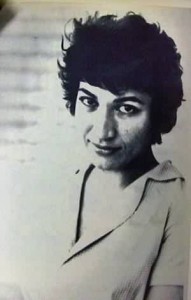 Iranian poet Forough Farrokhzad was born in 1935 in Tehran and is noted as one of the most influential female writers and film makers of her time. She studied dressmaking and art at Kamalolmolk Technical School where she also began to write her own poetry, before being engaged to marry noted satirist and writer Parviz Shapoor who was her cousin.
Iranian poet Forough Farrokhzad was born in 1935 in Tehran and is noted as one of the most influential female writers and film makers of her time. She studied dressmaking and art at Kamalolmolk Technical School where she also began to write her own poetry, before being engaged to marry noted satirist and writer Parviz Shapoor who was her cousin.
Her family objected to the marriage but Farrokhzad went ahead against their wishes, and a year later she gave birth to a son. The marriage did not last, however, and by 1954 she and Shapoor were divorced. After he won custody of their son, Farrokhzad moved back to her home town of Tehran and began trying to earn a living writing poetry.
Her first collection, The Captive, was published in 1955 but there was a considerable amount of negative criticism, mainly because she was a divorcee and writing about controversial things. The collection contained 44 poems and expressed her desire to be independent despite her sex. That same year she suffered from mental health problems, enduring a nervous breakdown for which she was hospitalized for a while.
On her release, for the first time in her life she left Iran and moved to Europe for the next 9 months. There she wrote her second collection The Wall, a series of short verses, and in 1958 she published Rebellion which set her apart as a young and exciting poet who was willing to discuss her own emotions and explore ideas that were considered risqué at the time.

One of her most important relationships was with Russian director and writer Ebrahim Golestan who instilled in her a love of film making and encouraged her to express her views. Shortly after meeting him, she made a film about Iranian men and women who were afflicted with leprosy in Tabriz and in 1962 The House is Black was released to general critical acclaim. In it Farrokhzad quotes passages from the Bible and Koran, as well as some of her own poetry.
In 1964, Farrokhzad published Another Birth which took a more feminist perspective in a country that was mostly male dominated. At the time she and Golestan were carrying on an affair, with the director spending the day with Farrokhzad before returning to his wife in the evening. She was beginning to gain more notoriety on the international stage – UNESCO produced a 30 minute documentary about her and she was interviewed by Bernardo Bertolucci.

In 1965 she wrote her last work, Let Us Believe in the Beginning of the Cold Season, a poem that was published shortly after her death. In 1967, after a trip to Italy, she was driving down the street and swerved to avoid hitting a bus, crashing into a wall. She did not recover from her injuries and died a short time later at the age of just 32.
When the Islamic Revolution spread throughout Iran in the following years, Farrokhzad’s work was banned for almost a decade. Her poetry has since been translated into several languages and she remains one of the most influential artists to have come out of Iran in the last century.

